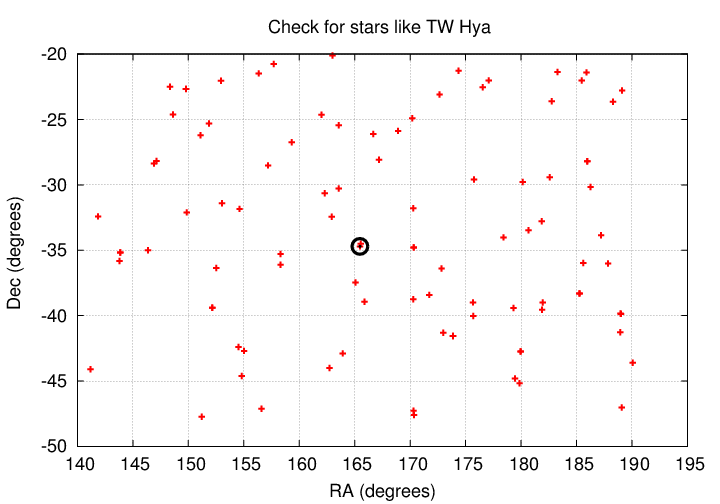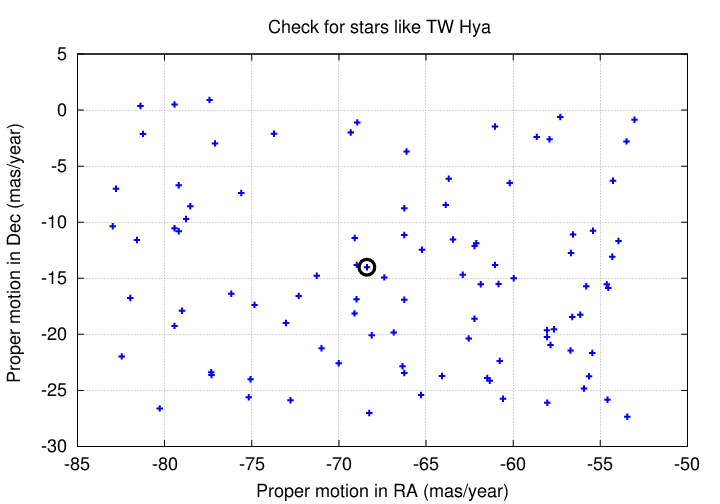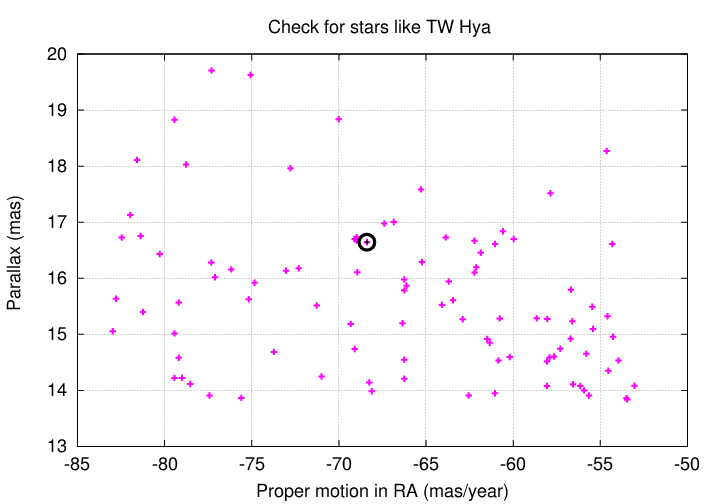
 Copyright © Michael Richmond.
This work is licensed under a Creative Commons License.
Copyright © Michael Richmond.
This work is licensed under a Creative Commons License.
After hearing of the possible new member of the TW Hya group, I was inspired to do a quick search for additional members using the Gaia DR2 archive. Using the
SELECT * FROM gaiadr2.gaia_source WHERE parallax >= 13.8 and parallax <= 19.8 AND ra >= 140.5 and ra <= 190.5 AND dec >= -50.0 and dec <= -20.0 AND pmra >= -83.0 and pmra <= -53.0 AND pmdec >= -28.0 and pmdec <= 2.0
Running this query took a few seconds and yielded a total of 97 objects. You can find an ASCII copy of the results here:
I've made a few plots to illustrate the properties of the resulting objects. In each plot, TW Hya is indicated by a big black circle.
Position on sky.

Proper motions.

Proper motion (RA) and parallax.

Color-magnitude diagram. The numbers are the indices of the stars in the result of the query (but offset by 1 -- so the first star in the list has label "2", the second star "3", and so forth). Click on the diagram below for a high-resolution Postscript version.
Looking at this figure, we see an ordinary main sequence, with a smaller number of stars delineating a second sequence just above it. These "superdwarfs" may be particular young stars --- like TW Hya, which is clearly a member of the second group.
The labels corresponding to these stars are:
61 44 19 (TW Hya) 74 81 80 91 56 2 69 72 48 83 50 92
And thus we can identify these stars in the list returned by our query to the Gaia database: they will be the 61th, 44th, 19th, etc., stars in the list.
Let's list these stars, shall we?
# n Gaia_source_id RA Dec parallax pmra pmdec Gmag Gagne 2MASS or other # (deg) (deg) (mas) (mas/yr) (mas/yr) 2 5414158429569765632 154.8231 -44.6267 14.7 -57.30 -0.61 12.521 n* J10191763-4437360 19 5401795662560500352 165.4659 -34.7048 16.6 -68.39 -14.02 10.439 y TW Hya 44 5374520249409189760 170.3407 -47.6009 14.1 -68.26 -27.02 9.980 n* J11212188-4736028 48 6147119548096085376 188.9536 -39.8403 14.0 -55.94 -24.83 12.963 y TWA 11C 50 3465989374664029184 180.6580 -33.4780 15.8 -66.25 -23.46 14.028 y TWA 36 56 3466308095597260032 181.8637 -32.7835 18.0 -72.78 -25.88 11.438 y TWA 23 61 5666748067585937408 149.7848 -22.6596 16.6 -61.04 -13.81 9.588 r J09590842-2239345 69 5397574190745629312 171.7136 -38.4154 14.5 -60.84 -15.51 12.961 n* J11265133-3824553 72 5460240959050125568 153.0377 -31.4126 18.8 -79.43 -10.54 12.714 y J10120908-3124451 74 5460728077057780864 154.6193 -31.8342 15.2 -56.61 -18.46 10.847 y TWA 6A 80 5399220743767211264 170.3223 -34.7806 16.7 -69.00 -16.87 10.904 y J11211745-3446497 81 5399220743767211776 170.3214 -34.7794 16.7 -69.10 -18.13 10.877 y J11211723-3446454 83 5378040370245563008 179.8658 -45.1721 14.1 -56.15 -18.25 13.070 h J11592786-4510192 91 5396105586807802880 170.2725 -38.7547 15.3 -62.90 -14.68 11.687 y TWA 12 92 5467714064704570112 157.1905 -28.5105 16.3 -65.23 -12.46 14.568 y TWA 34
The column labelled "Gagne" has
Note that 3 of these 15 stars (marked with n*) do not appear in Gagne et al. (2017). Perhaps they are new members of the TW Hya association.
 Copyright © Michael Richmond.
This work is licensed under a Creative Commons License.
Copyright © Michael Richmond.
This work is licensed under a Creative Commons License.